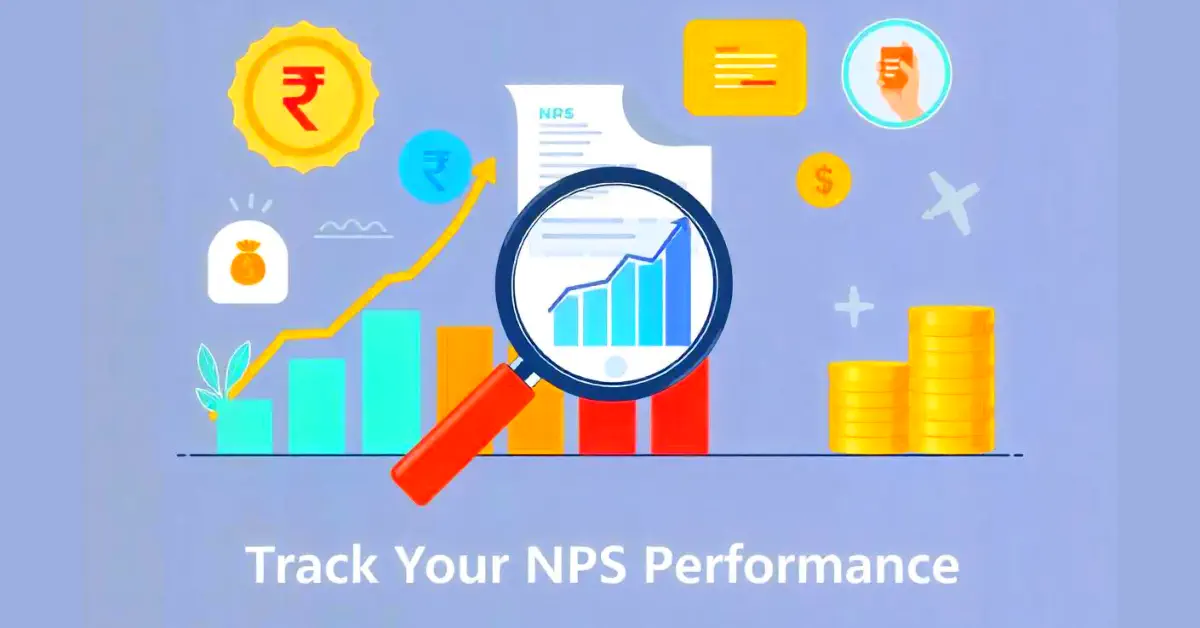How to Monitor the Performance of Your NPS Account for best returns

Introduction
The New Pension Scheme (NPS) is a government-backed retirement savings initiative designed to offer financial security to Indian citizens post-retirement. Launched in 2004, it allows individuals to build a retirement corpus through regular contributions that are invested in various asset classes such as equities, government bonds, and corporate bonds. Monitoring the performance of your NPS account is crucial to ensure it aligns with your financial goals and delivers optimal returns.
Let’s dive in and explore why monitoring your NPS is so important, the key metrics you should be keeping an eye on, and the various tools and platforms that can make the process simple. We’ll also take a look at some common mistakes to avoid while tracking your NPS performance to ensure you’re getting the most out of your retirement savings.
Why Is It Important to Monitor Your NPS Performance?
Monitoring your NPS account is essential for several reasons:
- Maximizing Returns: The returns on NPS are market-linked, meaning they can fluctuate based on how the markets perform. By actively monitoring your account, you can identify trends and make informed decisions to maximize returns.
- Adjusting Asset Allocation: NPS offers a choice between different asset classes, such as equities, corporate bonds, and government securities. Monitoring performance helps you adjust your asset allocation based on your risk tolerance and market conditions.
- Assessing Pension Fund Manager (PFM) Performance: Different PFMs yield different returns, and evaluating their performance regularly will help ensure your investments are in the hands of the best managers. NPS allows subscribers to switch PFMs if needed, so tracking their performance is key to optimizing returns.
- Aligning with Retirement Goals: Monitoring ensures that your NPS investments are on track to meet your long-term retirement goals, especially when considering factors like inflation and future financial requirements.
Key Metrics for Evaluating NPS Performance
To make the most out of your New Pension Scheme (NPS) investments, understanding and tracking the right metrics is crucial. These key performance indicators help you evaluate whether your NPS portfolio is on track to meet your retirement goals. Let’s explore the essential metrics you should monitor regularly:
1. Net Asset Value (NAV)
The Net Asset Value (NAV) is the price per unit of the NPS scheme, and it reflects the market value of all the assets in the portfolio. It fluctuates daily based on the performance of the underlying assets such as equities, bonds, and government securities. Monitoring NAV helps you:
- Track Growth: A higher NAV indicates that your investments have grown, while a lower NAV might signal underperformance.
- Compare Funds: NAV allows you to compare different Pension Fund Managers (PFMs) and their schemes. By analyzing the NAVs across funds, you can decide whether to continue with your current PFM or switch to a better-performing one.
You can view daily NAV updates on the NPS Trust Website.
2. Fund Return Performance
Another key metric is the overall return generated by the fund. NPS offers three asset classes: Equities (E), Corporate Bonds (C), and Government Bonds (G). Each asset class offers different return potential and risk levels. Regularly reviewing the return performance of each class will help you understand how well your investments are doing.
- Equity Returns (E): Equities tend to have higher volatility but also offer the potential for higher long-term returns. Monitor your equity returns, especially if your portfolio is equity-heavy.
- Corporate Bonds (C): Corporate bonds offer more stable returns than equities but less risk. It’s essential to track how corporate bonds are performing in relation to market interest rates and economic conditions.
- Government Bonds (G): Government bonds are the safest but usually offer the lowest returns. This is a good option for risk-averse investors or those nearing retirement.
Tip: Always compare your fund’s performance over different periods (1-year, 3-year, 5-year) to get a sense of its stability and long-term potential.
3. Performance vs. Benchmark Indices
One of the most important ways to assess your NPS portfolio’s performance is to compare it against relevant benchmark indices. For example:
- Equity funds can be benchmarked against indices like Nifty 50 or Sensex.
- Government Bonds can be compared to Government Bond indices.
If your PFM’s returns consistently outperform the benchmarks, it’s a sign that your investments are being managed effectively. On the other hand, underperformance might indicate a need to reconsider your fund allocation or switch PFMs.
4. Asset Allocation
The NPS allows you to distribute your investments across three asset classes—Equities (E), Corporate Bonds (C), and Government Bonds (G). The proportion of these assets in your portfolio is known as asset allocation.
- Equities: Higher risk but potentially higher returns, suitable for younger investors with a longer time horizon.
- Corporate Bonds: Moderate risk and moderate returns, suitable for those seeking a balance between growth and safety.
- Government Bonds: Low-risk and stable returns, best for conservative investors or those nearing retirement.
Monitoring your asset allocation helps you maintain the right balance based on your risk profile, age, and retirement goals. For instance, as you approach retirement, you might want to reduce exposure to equities and shift toward safer investments like bonds.
5. Historical Performance
Reviewing the historical performance of your NPS funds provides insights into how the fund has performed over the long term. By examining how the fund has reacted to different market conditions, you can gauge its resilience and potential for future growth.
- Look at 5-year or 10-year returns to understand how well the PFM has managed the fund across market cycles.
- Evaluate whether the fund has delivered consistent returns or if there have been significant fluctuations.
Tip: Consistent long-term performance, especially during market downturns, is a good indicator of a well-managed fund.
6. Risk-Adjusted Returns
While returns are important, it’s equally crucial to assess the risk-adjusted returns of your NPS portfolio. This metric measures how much risk the fund has taken to generate its returns. A high return with very high risk might not be ideal, especially for investors with a low risk tolerance.
Common risk-adjusted performance metrics include:
- Sharpe Ratio: This measures the excess return per unit of risk taken. A higher Sharpe ratio means better risk-adjusted performance.
- Standard Deviation: It shows how much the fund’s returns deviate from its average return. A lower standard deviation means the fund is less volatile.
7. Contribution vs. Return Growth
Keep track of the relationship between your contributions and the growth of your NPS corpus. This will help you understand whether the growth of your retirement fund is primarily driven by market performance or the amount you’re contributing.
- If the fund is performing well, you might need to make fewer additional contributions.
- If your portfolio is underperforming, consider increasing contributions or reviewing your PFM and asset allocation strategy.
Conclusion on Key Metrics
Monitoring these key metrics is essential to ensure your NPS investments are growing as expected and are aligned with your retirement goals. By keeping an eye on NAV, fund performance, asset allocation, and risk-adjusted returns, you’ll be in a better position to make informed decisions and optimize your portfolio for long-term success.
Tools and Platforms for Monitoring NPS Performance
Tracking your NPS performance has been made simpler through various tools and platforms. Here’s a detailed look at the official, mobile, and third-party platforms available for monitoring your NPS account:
1. Official Platforms
a. NSDL NPS Portal
The NSDL CRA (Central Recordkeeping Agency) portal is one of the primary platforms for NPS subscribers to track their account details. Here’s how to access your performance:
- Login: Visit the NSDL CRA website and log in using your PRAN (Permanent Retirement Account Number) and password.
- Fund Performance: You can view the performance of your chosen PFM and the NAV of your funds. Detailed reports on your contributions and asset allocation are available for easy review.
- Transaction Details: This platform gives you access to your entire transaction history, including contributions, withdrawals, and fund transfers.
b. KFintech NPS Portal
Similar to NSDL, KFintech CRA is another option for monitoring your NPS account:
- Login: Access your account via the KFintech CRA Portal with your PRAN and password.
- Portfolio Overview: The portal provides a comprehensive view of your holdings, including NAV, contribution history, and asset allocation.
- Fund Manager Comparison: Compare your PFM’s performance with other managers to determine if a switch would benefit you.
2. Mobile Applications
With the rise of mobile technology, NPS monitoring is now more convenient. Here are some apps that provide real-time updates on your investments:
a. NSDL NPS Mobile App
The official NSDL NPS Mobile App allows subscribers to monitor their accounts on the go:
- Real-Time Updates: Access your current NAV, view contributions, and track fund performance from your smartphone.
- Contribution Management: Make additional voluntary contributions or check the status of your contributions via the app.
- Account Overview: Review your Tier 1 and Tier 2 account details and check fund allocation.
b. KFintech NPS Mobile App
The KFintech Mobile App is another useful tool for tracking your NPS investments:
- NAV and Returns: Check the latest NAV of your funds and track the growth of your investments.
- Performance Analytics: Use detailed performance graphs to analyze your fund’s growth and benchmark it against other funds.
3. Third-Party Financial Aggregator Apps
Third-party financial platforms like ET Money, Groww, and Paytm Money offer a seamless way to track your NPS performance along with your other investments. These apps provide features such as fund comparisons, asset allocation management, and tax benefit analysis.
a. ET Money
ET Money allows NPS subscribers to track and manage their NPS accounts alongside mutual funds and other financial products. You can:
- Track NAV, asset allocation, and fund performance.
- Set retirement goals and see how your NPS contributions fit into your overall financial plan.
- Compare your PFM’s returns with other PFMs.
b. Groww
Groww is an easy-to-use platform where you can monitor NPS performance and explore fund switching options. Features include:
- Viewing NAV and return history.
- Accessing reports to compare the performance of different PFMs.
- Analyzing tax savings through your NPS contributions.
c. Paytm Money
Paytm Money is another popular platform that integrates NPS performance tracking:
- Get a snapshot of your NPS investments alongside your other portfolios.
- Track fund performance and compare it with mutual funds or other investment options.
- Manage contributions and withdrawals directly from the app.
4. NPS Trust Website
The NPS Trust website provides daily updates on NAVs for all pension fund schemes. It also offers performance reports for each PFM, allowing you to benchmark their returns against market indices and other funds. This platform is an excellent resource for analyzing long-term fund performance and market trends.
Common Mistakes to Avoid While Monitoring NPS
While monitoring NPS is essential, there are common mistakes that investors make, which can hinder long-term gains:
- Overreacting to Short-Term Market Fluctuations: NPS is a long-term investment, so avoid reacting impulsively to daily NAV fluctuations. Stay focused on your long-term retirement goals.
- Ignoring Your Risk Profile: As you age, your risk tolerance decreases. Failing to adjust your asset allocation (e.g., reducing equity exposure as you near retirement) can result in higher risks.
- Switching PFMs Too Often: While it’s possible to change PFMs once a year, frequent switches based on short-term performance can lead to inconsistent returns.
- Not Rebalancing Your Portfolio: Regularly review and rebalance your asset allocation, especially if market conditions or your financial goals have changed. Ignoring this can result in an unoptimized portfolio that either takes on too much risk or yields insufficient returns.
Conclusion
Monitoring the performance of your NPS account is vital to ensuring that your retirement corpus grows efficiently and stays aligned with your financial goals. By understanding key metrics such as NAV, fund returns, and asset allocation, and by using the right tools and platforms, you can track your NPS performance with ease. Additionally, being aware of common mistakes like overreacting to market fluctuations or neglecting your risk profile will help you avoid pitfalls and stay on course for a financially secure retirement.
Use the official portals and mobile apps offered by NSDL and KFintech, or leverage third-party platforms like ET Money and Groww to manage your NPS account effectively. Regular monitoring and timely adjustments will ensure you maximize your returns and achieve your retirement goals.




